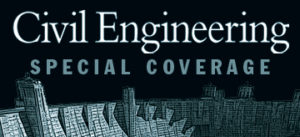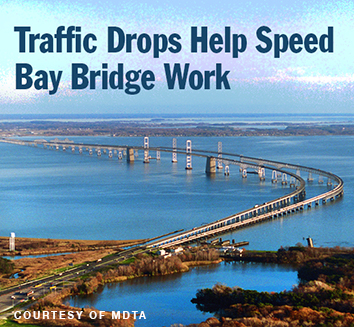ON APRIL 1, Governor Larry Hogan of Maryland announced that despite the COVID-19 outbreak, a portion of the William Preston Lane Jr. Memorial Bridge’s current rehabilitation project finished ahead of schedule. The dual-span bridge, which crosses the Chesapeake Bay and connects Maryland’s Eastern Shore to the western part of the state, is commonly referred to as the Chesapeake Bay Bridge. Like many construction projects in the United States right now, work on the bridge is taking place while strict safety guidelines are being followed to mitigate the spread of COVID-19 among essential construction workers.
Maryland is in a state of emergency, and nonessential businesses are closed because of COVID-19. The resurfacing of the westbound crossing’s deteriorated right lane was completed ahead of schedule due in part to lower-than-normal traffic volumes.
The dual-span bridge comprises two 4.3 mi long bridges, one built in 1952 and the other in 1973. The eastbound span carries two lanes of traffic toward the Eastern Shore, while the westbound span carries three lanes of traffic toward the main portion of Maryland. In the winter, 28,000 vehicles cross daily in both directions; in the summer that number jumps to 45,000.
The project involving the right lane of the westbound crossing continued during the pandemic because state and federal guidelines deem transportation as an essential and critical function, explained William N. Pines, P.E., the chief engineer for the Maryland Transportation Authority (MDTA). The MDTA is responsible for constructing, managing, operating, and improving the state’s toll facilities, which include the Chesapeake Bay Bridge.
On March 20, the Maryland Transportation Builders & Materials Association (MTBMA) published safety guidelines for work undertaken during the pandemic. Those jobsite practices are being followed by the MDTA, Pines explains.
Beyond the Usual Measures
The MTBMA guidelines were developed on the basis of information from the Centers for Disease Control and Prevention and in collaboration with the Maryland Department of Transportation, according to Michael Sakata, the president and chief executive officer of the MTBMA. The association also used other transportation construction state associations’ best practices as it created guidelines, Sakata says.
In addition to the typical five recommendations that many governmental bodies have shared—frequently wash your hands, cough into your elbow, don’t touch your face, stay 6 ft apart from others, and stay home if you feel sick—the guidelines include a number of others. Supervisors are directed to ask individual workers four questions every day before they are allowed on a jobsite:
- Have you or anyone in your family been in contact with a person who has tested positive for COVID-19?
- Have you or anyone in your family been in contact with a person who is in the process of being tested for COVID-19?
- Have you been medically directed to self-quarantine due to possible exposure to COVID-19?
- Are you having trouble breathing or have you, within the past 48 hours, had flu-like symptoms, including fever, cough, shortness of breath, sore throat, runny/stuffy nose, body aches, chills, or fatigue?
The guidelines direct that anyone who answers yes to any of these should leave the jobsite immediately.
In addition to supplying hand sanitizer and handwashing stations, the guidelines specify that site supervisors should clean and disinfect all frequently touched equipment surfaces and vehicles at the beginning of and during each shift, with special attention paid to handles, controls, keyboards, doors and doorknobs, and faucet handles. Workers are directed that they should not congregate in lunch areas or share tools or personal protective equipment.
The use of disposable items on-site is preferred to minimize cross contamination. The guidelines direct that jobsites should provide individual water bottles (instead of a common water cooler) and use disposable hand towels and gloves when appropriate. Shoes should be sanitized before entering and upon leaving a site, and workers should immediately change their clothing upon arriving home and wash their clothing in hot water with laundry sanitizer.
The use of pressurized air or water sprays to clean sites is discouraged because it may generate bioaerosols that can then be inhaled, according to the guidelines.
Keeping Projects Moving
Following these MTBMA-recommended jobsite practices enables the MDTA to “continue to perform … critical functions while protecting the health and well-being of our team,” Pines says.
With the completion of the westbound right-lane project on the Chesapeake Bay Bridge, the lane’s service life was extended by 20 to 25 years, according to Pines. Work can now move forward on the span’s center- and left-lane projects, including deck sealing, steel railing replacement, and deck joint repairs and replacements as well as the replacement of overhead signals. That work will continue under the COVID-19 safety guidelines.
“The MDTA’s top priority remains the safety of our customers, employees, and contractor/consultant partners during the COVID-19 state of emergency,” Pines says.


